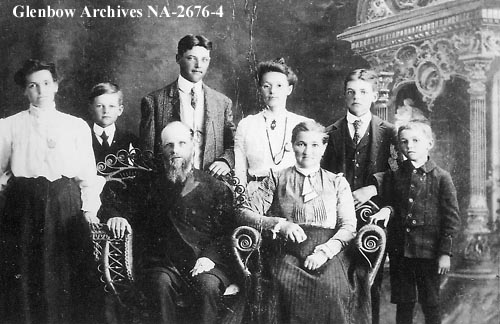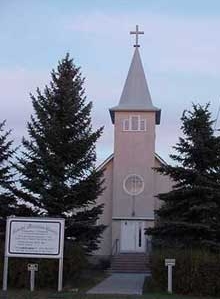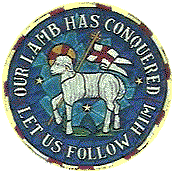
The MoraviansDefinitionThe Moravian Church is a mainline Protestant denomination with more than five hundred years of history. Founded before the Lutheran, Presbyterian, or Methodist churches, Moravians have long focussed on faithful living and Christian unity. They are encouraged to live their faith out through service to those in need, and their mission work has concentrated on the poor and the powerless. An early motto of the denomination is followed to this day: "In essentials, unity. In non-essentials, liberty. But in all things, love." Their name derives from the fact that most early members of the church came from the province of Moravia, now in the Czech Republic. Most Moravians in western Canada are the descendants of German-speaking emigrants from 19th-century Russia, predominantly Volhynia. HistoryThe Moravian church traces its beginnings to the pre-reformation teachings of Jan Hus, a Czech reformer and philosophy professor at the University in Prague. He led a protest movement against certain doctrinal positions of the Roman clergy and hierarchy and was accused of heresy, tried and burned at the stake in 1415. But his followers gathered on an estate in eastern Bohemia and organized this church in 1457-60 years before Martin Luther began his reformation. By 1517 the Moravian numbered at least 200,000. Using a hymnal and a catechism of its own, the church promoted the Scriptures through its printing presses and provided the people of Bohemia and Moravia with the Bible in their own language. Moravians were also early in their emphasis on educating women as well as men, and they were pioneers of the Protestant mission movement. The Moravian Church was bitterly persecuted in its homeland, and as a consequence spread to Poland where it grew rapidly. There was more persecution during the Thirty-Years' War, but in the 18th century the church saw a renewal through the patronage of Count Nicholas of Zinzendorf, a pietist nobleman in Saxony. Some Moravians fled from persecution in Bohemia and Moravia and found refuge on Zinzendorf's estate in 1722 where they built the community of Herrnhut (Lord's Watch). Zinzendorf encouraged them to take the gospel to the far corners of the globe. In 1732 the first missionaries were sent to the West Indies. In 1735 the Moravians came to America and tried, unsuccessfully, to establish a Moravian settlement in Georgia, but soon after settled in Pennsylvania. Other settlement congregations were in New Jersey and Maryland, and later in North Carolina. Settlement in CanadaThe Moravians also came to Canada and established missions in Labrador between 1752 and 1771; over time, congregations were established in Nain, Hopedale, Makkovik, Postville, Happy Valley, and Northwest River. Today, only Nain, Hopedale and Makkovik remain on the coast, along with Happy Valley/Goose Bay. Moravian congregations exist still in Labrador's Inuit communities. Distinctive Moravian buildings, once characteristic of all the mission stations, survive at Hopedale and Hebron under the care of Parks Canada. There are eight congregations in the Province of Alberta and one congregation in Toronto. According to the 2001 Census, there were 5,330 Moravians in Canada of whom 2,495 lived in Newfoundland, 560 in Ontario, and 2,035 in Alberta; of those, 1,260 lived in Edmonton and 610 in Calgary. Moravians in the Edmonton region
The Bruderheim community was started as a Moravian settlement by German-speaking emigrants from Volhynia, Russia, in 1894. The Moravian congregation was officially organized under lay pastor Andreas Lilge in 1895. He had served as a teacher and lay-leader in Volhynia from 1878 to 1892 and planned to bring Volhynian Moravians to Canada where religious freedom was guaranteed and Christian communities could be formed on land made available by the government. About 100 families responded to the invitation, and in May and June 1894, the first immigrants arrived. In 1895 the Bruderheim Moravian Church was established in her present location (it is still standing, but no longer in active use). The congregation numbered 44 adults, 16 youths and 51 children. One month later, in South Edmonton, in present-day Mill Woods, the Bruederfeld Moravian Church was established. In 1896, Moravian work also began in Heimthal, south of Edmonton. Groundwork was also laid in Beaver Hills on which other denominations would build. In 1896, the first pastor, the Rev. Clement Hoyler, arrived; he was joined by a co-pastor, the Rev. William Schwarze.
The Moravian community was among the first Protestant congregation in Western Canada. To serve the multilingual immigrant population that had settled in the Edmonton region, worship services from the beginning were conducted in the vernacular of the various groups, e.g., in German, English, Norwegian, Russian, and Ukrainian. Gottfried Henkelmann, like Lilge a former teacher in Volhynia, joined the Bruederfeld congregation and was the resource person for Russian and Ukrainian ministries. Alberta's Moravian congregations are the following: Edmonton (Edmonton Moravian Church, Rio Terrace Church, and Millwoods Church), Sherwood Park (Good News Moravian Church), Bruderheim (Bruderheim Moravian Church), Rural South Edmonton (Heimtal Moravian Church), and Calgary (Good Shepherd Church and Christ Church). Six of them are thriving. In 2002, there were 1,332 Moravians in Alberta; the average attendance at Sunday worship services was about 100. Church activitiesMoravians churches are fairly active for their congregation and the surrounding community (all activities are carried out in English, and the churches do not operate Saturday language schools). They organize bible study classes, youth activities and outreach programs for seniors, and the support of mission work plays a very large role. They either organize or sponsor programs—such as a soup lunch for needy people once a month and the Alpha program—and offer their facilities for AA and anti-violence programs for the community at large. Although the congregations are independent in organizing their activities, they do come together on a number of occasions each year. For example, at Christmas their choirs and musical groups share Christmas music with the members of the other churches. They hold an annual Camp Sunday at Camp Van Es on Cooking Lake, which is always attended by 150 to 200 people. Also, about once a year members of other congregations are invited when one of the churches holds a district mission event where someone from a mission shares his or her experiences with the faithful. Church structureEach congregation in Alberta has a governing board and runs its own affairs under the auspices of the Canadian District Board which consists of laypeople and, often, clergy. The local board can decide on church activities and even determine the character of worship in their church. The District Board has a purely administrative function in that it fills pastoral vacancies, and conducts and operates synods on a regular basis. The bishop's role is "to serve as a pastor to pastors." The Canadian Moravian Historical Society with headquarters in Edmonton is a non-profit society; its board members-who have to be Moravians-are elected annually. The Society undertakes several important initiatives: 1. It manages the Canadian Moravian Archives (2304-38 St., Edmonton, AB, T6L 4K9, phone: (780) 440-3050, fax: (780) 463-2143) that preserve the records of the World Wide Moravian Unity, Northern Province and Canadian District, which in includes British Columbia, Alberta, and Saskatchewan. The Archives also maintain congregational records of individual Moravian churches in Western Canada, Camp Van Es, and the personal papers of the Reverend Clement Hoyler. The holdings date from 1882 and encompass ca. 20 meters of documents, diaries, books and other writings. 2. The Society publishes the Western Canadian Moravian Historical Magazine, a newsletter to the community, and historical books and booklets. It also organizes events of historical significance at least once annually and occasionally sets up displays at, for example, synods and anniversary celebrations. Selected traditions
The seal of the Moravian Church goes back to the 16th century. In the centre is the Lamb of God, a favourite symbol of the early Christian church. A lamb is holding a staff, and from the staff waves a banner of victory. On the banner a cross is clearly displayed. The inscription reads "Our Lamb has conquered, let us follow him." On the first Sunday in Advent, lighted stars, symbolizing Christ as the Light of the World, are hung in Moravian churches and homes; they likely originated in a Moravian school in Niesky (Saxony, Germany) in the 1850s. Many Moravians recreate the Nativity Scene by assembling an elaborate Putz in their homes or place of worship. On Christmas Eve, candlelight services are held with beeswax candles trimmed in a skirt of fireproof red paper. They are to remind worshipers of the purity and sacrificial gift of Christ. The Lovefeast is an informal yet dignified service that dates back to 1727. The basic structure is alternate singing by the congregation and by choirs. There usually is no sermon. After an opening hymn and a prayer, the worshipers are served a sweet bun and beverage. After all are served, the congregation partakes in unison demonstrating the congregation's family spirit and promoting Christian fellowship. Many Moravians start their day with a reading from the Moravian Daily Texts. Each day's selections include an Old Testament Verse, a hymn stanza fitting the verse; a New Testament verse on a related theme with its matching hymn selection, and a brief prayer for the day. Sources1. Bruderheim Moravian Church, http://www.connect.ab.ca/~bmc/index.htm. History of the congregation, links to other Moravian churches, addresses. 2. Edmonton Moravian Church, http://www.edmontonmoravian.com/. Website of the Edmonton Moravian Church. 3. Rio Terrace Community Moravian Church, http://fm2.forministry.com/Church/church.asp?SiteId=T5R2Z9RTCMC. Website of the Rio Terrace Community Moravian Church. 4. Good Shepherd Church, http://www.goodshepherdmoravian.org/. Website of the Good Shepherd Church; history, traditions and symbols. 5. Canadian District Moravian Churches, http://www.mcnp.org/Churches/churches.asp. Links to churches in Alberta, 6. The Moravian Church in Canada, http://www.moravian.ca/. Official web page of the Moravian Church in Canada. 7. Establishment of the Moravian Church in Labrador, http://www.mun.ca/rels/hrollmann/morav/index.html. Map of the Moravian missions to Labrador 8. The Moravian Church, http://collections.ic.gc.ca/agvituk/moravian.htm. Moravians in Labrador. 9. The Moravian Church in North America, http://www.moravian.org/. History, beliefs, daily texts, etc. 10. Canadian Moravian Archives, http://asalive.archivesalberta.org:8080/access/repos/rep/display/cma. Contact details and access to Archives Network of Alberta. 11. Moravian Church Genealogy Links, http://www.enter.net/~smschlack/. Collection of links to websites on the history of the Moravian Church in North America. 12. Short Introduction to the History, Customs and Practices of the Moravian Church, http://www.everydaycounselor.com/ archives/sh/shistory.htm. 13. 1853 Moravian Atlas, http://bdhp.moravian.edu/maps/1853moravianatlas.html. Map of Moravian settlements in the U.S. and Canada. 14. Volhynia District Map, http://www.rollintl.com/roll/volhynia.htm. |



